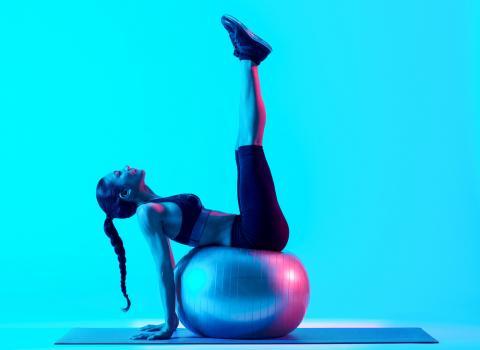
Mind-body exercises intended to harmonize the body have been trending in our culture for years now. Yoga poses elegantly shared on our Instagram and Facebook and other social media sites picture long-limbed profiles of our friends mid-stretch with hands and toes reached out to emphasize the beautiful lines and symmetry of their practiced bodies. The pictures we share may seem vain at times; however, the positive value of these poses reflects a conscious effort toward balanced symmetry, flexibility and total alignment of the body as part of a lifestyle toward holistic health. But yoga isn’t the only way to achieve this alignment – physically or otherwise. In fact, Pilates is often an unsung hero of achieving this mind-body connection that also offers a great workout to get stronger and tone your core. Emerging out of ancient mind-body healing philosophies like Yoga and Ayurveda is the practice of Pilates.
As part of my exercise routine, I practice Pilates anywhere from 3-5 times a week for approximately 30 to 45 minutes a session. I prefer Pilates as my exercise of choice because I find it to be more energizing than other mind-body workouts, allowing me to work isolated muscle groups at a faster rate while maintaining a proper form and alignment with my spine. Pilates’ moves focus on breathing correctly while mindfully contracting and holding your pelvic alignment in line with smooth flowing movements to create a strong core and back that deeply define the abdominal muscles that line our spines. These exercises create leaner muscles and better joint mobility, therefore decreasing the chance of injury due to exercising. In the words of Joseph Pilates, “sports are wonderful … but of little value for correcting what’s wrong with you … corrective exercise is the only way to build a beautiful, strong, youthful body.”
At the turn of the 20th century, German gymnast and physical innovator Joseph Pilates introduced and then established the once ancient practice of mind-body exercises to Western culture. Upon moving to England two years before the breakout of WWI, in 1914 the British Authorities interned him in an internment camp along with other German citizens where he began teaching wrestling and self-defense. As he began to learn how much mental and physical health were interrelated, his teachings gradually turned into his minimal equipment mat exercise system known then as “contrology” or today’s Pilates exercising methods. He continues to explain in his 1939 book, Your Health, “practically all human ailments are directly traceable to wrong habits which can only be corrected through the immediate adoption of right (natural, normal) habits… in order to form balance, grace and healthy alignment to the body from the inside out.”
Top 10 Benefits of Pilates
1. Improves Flexibility: Pilates requires you to move your body in several planes of motion allowing an increased range of movement throughout the body.
2. Reinforces Strong, Mobile Joints: Pilates exercises improve your muscle flexibility by elongating and strengthening your muscles, thereby protecting your joints from stiffness and conditions of the joints like arthritis.
3. Improves Bone Density: Resistance exercises that involve muscles pulling on bones create a tension which then fortifies the bone.
4. Promotes Weight-loss: In one experimental study, the effectiveness of Pilates greatly improved the postural alignment and health of twenty middle aged women who biologically enter a stage of physiological aging due to changes such as decreased muscle mass, hormonal fluctuations due to menopause, and increased body fat. The variable group that participated in a Pilates exercise session three times a week for twelve weeks were evaluated with a body composition analyzer and a three-dimensional scanner that concluded that their height increased and body fat decreased.
5. Relieves Back Pain Naturally: Research collected from a randomized control trial confirmed the effectiveness of Pilates as an exercise intervention for pain prevention in sufferers of nonspecific lower back pain (NSLBP). Thirty-eight participants were allocated randomly to either a control or experimental group in a 14-week Pilates program under the supervision of an exercise specialist yielding improvements in pain as it relates to effective posturography (posture) outcomes.
6. Strengthens Your Core: By contracting your abdominal and back muscles with almost every exercise, Pilates successfully strengthens all of the muscles that circle your spine and are known as your core. With proper form and repetition, core muscles strengthen.
7. Prevents Injury: Pilates reduces the factors usually associated with injury, like inflexibility, weak muscles and poor balance.
8. Gives You Better Posture: Muscular imbalances occur for many reasons, like looking at our smart phone for too long or slouching often; however, Pilates helps to reverse the effects of our bad habits by developing our muscular symmetry overtime. A strong back and core allow you to move through daily life not only without pain but with correct posture.
9. Promotes Body Awareness: Pilates reinforces a healthy connection between your mind and body. Performing corrective exercises has you become more mindful of your body, allowing you to mitigate pain and form healthy habits of motion.
10. Defines Muscles: Pilates amps up your abdominal workout from the inside-out by targeting intrinsic muscles deep in the center of your core. With a balanced diet, your abs will be noticeably defined!
REFERENCES
Hoffman, Jonathan, and C. Philip Gabel. “The Origins of Western Mind–body Exercise Methods.” Physical Therapy Reviews 20.5-6 (2015): 315–324. PMC. Web. 29 Nov. 2016.
Lee, Hyo Taek et al. “Effect of Mat Pilates Exercise on Postural Alignment and Body Composition of Middle-Aged Women.” Journal of Physical Therapy Science 28.6 (2016): 1691–1695. PMC. Web. 29 Nov. 2016.
Patti, Antonino et al. “Pain Perception and Stabilometric Parameters in People With Chronic Low Back Pain After a Pilates Exercise Program: A Randomized Controlled Trial.” Ed. Roman Leischik. Medicine 95.2 (2016): e2414. PMC. Web. 29 Nov. 2016.
Roh, Su Yeon. “Effect of a 16-Week Pilates Exercise Program on the Ego Resiliency and Depression in Elderly Women.” Journal of Exercise Rehabilitation 12.5 (2016): 494–498. PMC. Web. 29 Nov. 2016.
Roh, SuYeon, Ho Jong Gil, and Sukhoon Yoon. “Effects of 8 Weeks of Mat-Based Pilates Exercise on Gait in Chronic Stroke Patients.” Journal of Physical Therapy Science 28.9 (2016): 2615–2619. PMC. Web. 29 Nov. 2016.
[US1]Link to jaima’s strong core article








